Beretta M9A3 9mm Pistol, FDE w/ Blk Slide – JS92M9A3NT For Sale
$998.98
The Beretta M9A3 9mm Pistol, featuring a Flat Dark Earth finish with a Black Slide, is a highly adaptable and durable firearm tailored for military, law enforcement, and VIP protection needs. It offers a Vertec-style thin grip for improved comfort and control, along with a versatile universal slide design that can switch from a safety-decocker to a decocker-only mode. The pistol facilitates rapid magazine changes through a beveled magazine well and oversized release button, critical for high-stakes situations. Its 3-slot MIL-STD-1913 Picatinny rail supports various tactical accessories, while the polymer recoil guide rod balances durability and weight for extended use. Designed for versatility, it includes both straight and wrap-around backstrap grip options to suit different hand sizes, enhancing comfort and performance. The M9A3 is suitable for home defense, tactical competitions, and duty carry, with a design that meets NY/NJ compliance for broader legal accessibility. Note that the product image is illustrative and provided by the manufacturer.
Is the Beretta M9A3 discontinued?
Yes, the Beretta M9A3 has been discontinued.
Why did the army reject the M9A3?
The U.S. Army rejected the Beretta M9A3 due to their interest in pursuing a new handgun as part of the Modular Handgun System (MHS) program. They were looking for a pistol that offered modularity and other modern features that the M9 and its upgraded version, the M9A3, did not fully align with. The MHS program ultimately led to the selection of the SIG Sauer P320, designated as the M17 and M18, which offered the desired modularity, enhanced ergonomics, and adaptability to new accessories and ammunition standards.
What is the difference between M9A3 and M9A4?
The primary differences between the M9A3 and M9A4 pertain to design refinements and additional features for improved performance and adaptability. Here’s a breakdown of the main distinctions:
1. **Optics Compatibility**: The M9A4 typically includes a slide that is optics-ready, allowing for the attachment of red dot sights, which is a feature not present in the M9A3.
2. **Grip Options**: The M9A4 may offer more modular grip options, allowing users to customize the size and feel, enhancing ergonomics compared to the M9A3.
3. **Safety Features**: There might be differences in safety features between the two models, such as the design and operation of manual safety levers and decocking functions.
4. **Accessory Rail**: Both models have accessory rails, but there might be improvements or slight variations in design or compatibility in the M9A4 that support more accessories.
5. **Other Enhancements**: The M9A4 could offer improved internals or other minor enhancements aimed at reliability and performance based on user feedback or evolving tactical requirements.
These differences make the M9A4 more customizable and potentially more versatile, especially for users who require modern optics and highly adaptable configurations.
Is Beretta M9 better than 92FS?
The Beretta M9 and the Beretta 92FS are fundamentally very similar, as the M9 is a military designation of the 92FS. Both models share most features, such as design, caliber (9mm), and capacity. However, there are some slight differences primarily in the markings and certain specifications adjusted for military use in the M9.
1. **Markings and Features**:
– The M9 typically has additional military markings and slightly different safety components compared to the commercial 92FS.
– The 92FS might have a different finish or sight styles based on civilian preferences.
2. **Use Case**:
– The M9 is designed to meet U.S. military specifications, suggesting a focus on reliability and durability in combat situations.
– The 92FS is more versatile in terms of civilian and police usage options.
In general, whether one is “better” than the other depends on the specific needs and preferences of the user. If you are looking for a historically military-used model, the M9 might align with your interests. If you prefer a model that might have more civilian-friendly or aesthetically varied options, the 92FS could be preferable. Essentially, the best choice would depend on what features or uses are most important to you.
What Beretta did the Navy SEALs use?
The Navy SEALs have historically used the Beretta M9 as their standard sidearm. However, they also used the modified Beretta 92FS, known as the M9 Special Operations Forces (M9 SOF), which includes additional features tailored for special operations. More recently, they have shifted to using the SIG Sauer P226 and the Glock 19 for various missions as part of a broader transition to different sidearms.
Why is Beretta so expensive?
Beretta firearms are often considered expensive due to a combination of factors including:
1. **Quality and Craftsmanship**: Beretta is known for high-quality craftsmanship and attention to detail in manufacturing. The use of superior materials and precise engineering contributes to the overall cost of their products.
2. **Reputation and Heritage**: As one of the oldest firearm manufacturers in the world, Beretta has built a strong reputation for reliability and excellence. This prestigious heritage can add to the perceived value and price of their products.
3. **Innovation and Technology**: Beretta invests in research and development to incorporate the latest technology and innovations into their firearms. This investment in advanced features and design can increase production costs.
4. **Manufacturing Location**: Many Beretta products are manufactured in Italy, where the cost of labor and production can be higher compared to other regions.
5. **Customization and Variety**: Beretta offers a wide range of models, some of which have custom features or are part of limited editions. These unique offerings can have a higher price tag due to their exclusivity and additional customization.
6. **Market Positioning**: Beretta positions itself as a premium brand, and its pricing reflects this market segment. The higher price can also be a result of brand positioning and marketing strategy.
Overall, the combination of quality, heritage, innovation, and brand reputation contributes to the higher cost of Beretta firearms.
What year did the Beretta M9A3 come out?
The Beretta M9A3 was introduced in 2014.
Why did the military stop using the Beretta M9?
The U.S. military decided to replace the Beretta M9 primarily due to the need for a more modern, versatile, and reliable sidearm that better suited the diverse needs of contemporary soldiers. The Beretta M9, which had been in service since the 1980s, was replaced by the SIG Sauer P320, designated as the M17 and M18, as part of the Modular Handgun System (MHS) program. The reasons for this change included:
1. **Customization and Modularity**: The new system allows for more modularity, meaning that the pistol can be more easily adapted to various roles and user preferences with interchangeable components like grips and slides.
2. **Improved Ergonomics**: The SIG Sauer P320 offers improved ergonomics and features such as a more comfortable grip and better balance, which can enhance shooter performance.
3. **Enhanced Reliability and Performance**: Advances in firearm technology since the M9’s adoption led to an interest in a sidearm with enhanced reliability, accuracy, and performance, particularly in varied environmental conditions.
4. **Ammunition Flexibility**: The new system also accommodates different calibers, although the standard issue remains the 9mm. This flexibility was a consideration to potentially meet various operational needs.
5. **Safety Features**: The P320 includes enhanced safety features, such as improved drop safety mechanisms.
These updates were part of an overall effort to ensure that U.S. military personnel are equipped with the most effective and adaptable weapons available for current and future combat scenarios.
Does the M9A3 have a safety?
Yes, the M9A3 does have a safety. It features an ambidextrous manual safety/decocker lever.
How accurate is the Beretta M9A3?
The Beretta M9A3 is known for its accuracy due to various design enhancements. It has a 5-inch barrel, which contributes to its accuracy potential, and features a Vertec-style thin grip that aids in better control and handling. Additionally, the addition of a dovetailed front sight allows for improved sight alignment. Overall, the M9A3 is considered a reliable and accurate handgun, suitable for both tactical and personal defense use. Specific accuracy can vary based on factors like ammunition, shooter skill, and maintenance, but the M9A3 is generally well-regarded in terms of accuracy among pistols of its class.
Is the M9A4 decocker only?
Yes, the Beretta M9A4 features a decocker-only design.
What is the effective range of the Beretta M9A3?
The effective range of the Beretta M9A3 is approximately 50 meters (about 55 yards).
What year did the Beretta M9A3 come out?
The Beretta M9A3 was released in 2015.
When did they stop making the Beretta?
The specific Beretta model you are referring to is not mentioned in your question. Beretta is an Italian firearms manufacturer that produces a wide range of firearms, and they have not stopped making firearms altogether. If you are asking about a particular model, please provide more details so I can give you accurate information.
Why did the military stop using the Beretta M9?
The U.S. military stopped using the Beretta M9 as its standard-issue sidearm and transitioned to the SIG Sauer P320, known as the M17 and M18, as part of the Modular Handgun System program. The switch was influenced by several factors:
1. **Customization and Modularity:** The SIG Sauer P320 offers greater modularity, allowing for easy customization of grips, caliber, and barrel length to suit different missions and user preferences.
2. **Advanced Features:** The new handguns come with modern features such as improved ergonomics, rail systems for attachments, and advanced safety mechanisms.
3. **Performance and Reliability:** The military sought a more reliable weapon with better performance standards. The P320 reportedly offered superior accuracy, reliability under various conditions, and a longer service life.
4. **Cost-Effectiveness:** The contract for the P320 reportedly offered a cost-effective solution, providing better value in the long run.
These factors, among others, led to the transition from the Beretta M9 to the SIG Sauer models.
| Product Line | M9A3 |
|---|---|
| Action | Single/Double |
| Sights | Removable Dovetail/Tritium Night Front, Tritium Night Rear |
| Sight Radius | 6.3" |
| Slide | Black Steel |
| Safety | Ambidextrous |
| Grips | Black Polymer |
| Frame Material | Steel |
| Frame Finish | Flat Dark Earth |
| Overall Length | 8.7" |
| Overall Height | 5" |
| Overall Width | 1-1/2" |
| Barrel Type | Threaded |
Be the first to review “Beretta M9A3 9mm Pistol, FDE w/ Blk Slide – JS92M9A3NT” Cancel reply
Related products
Beretta M9A3
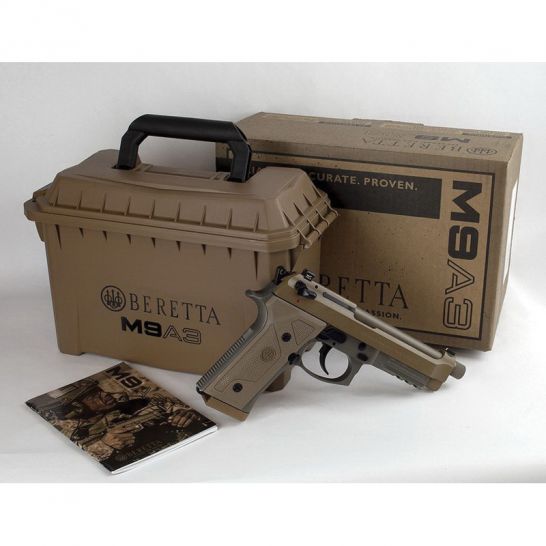
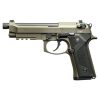
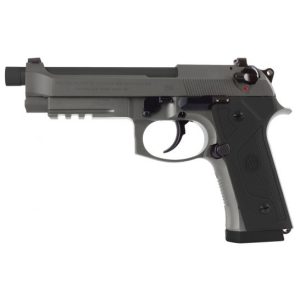
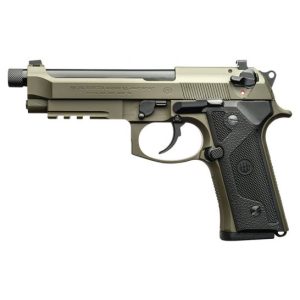
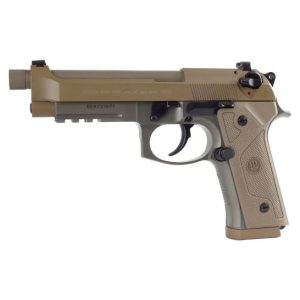
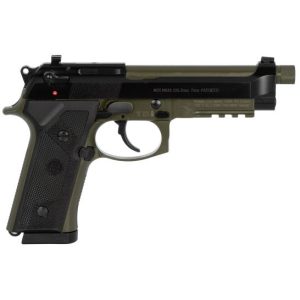
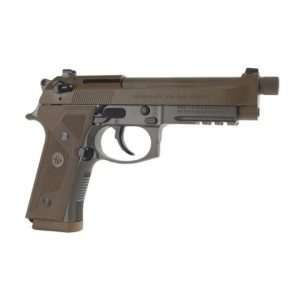
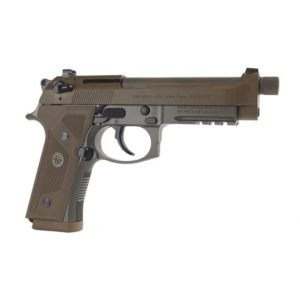
Reviews
There are no reviews yet.